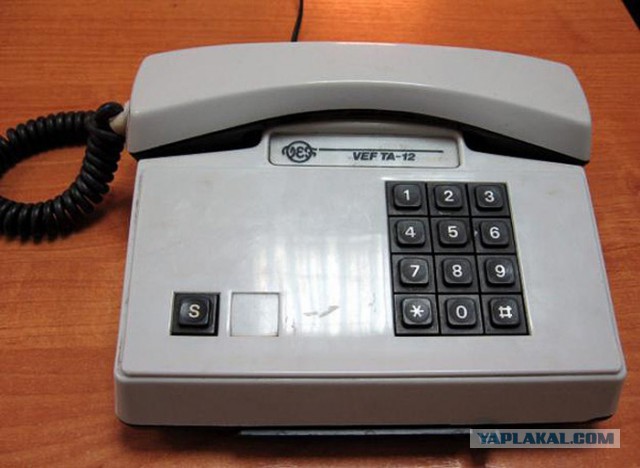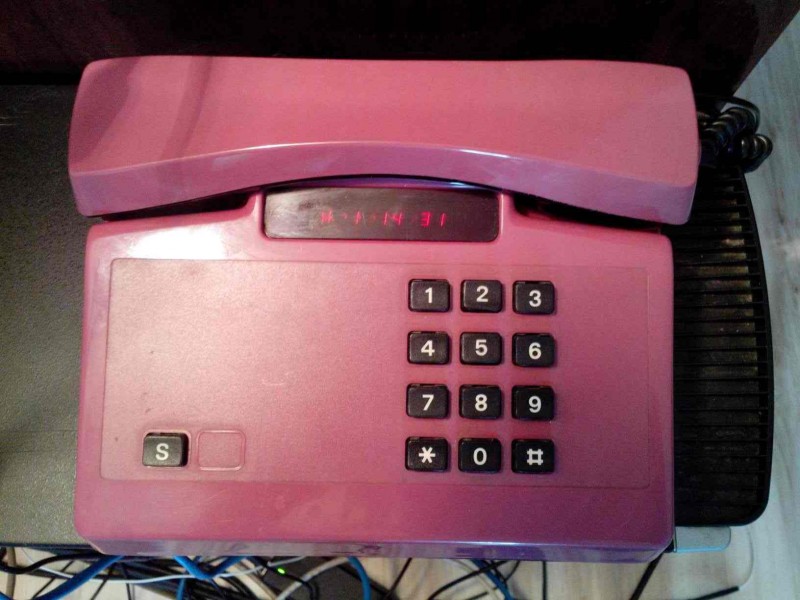AON
In 1991, I was a small boy living in Moscow. Those were crazy times (apparently — I wasn’t old enough to know, but it was just before the August Putsch), and a family friend — let’s call him Eddie — was trying to make some money by selling upgraded phones.
These phones were based on a standard button phone (most phones back then had rotary dials, keypads were quite rare, as I remember) manufactured by the Latvian company VEF, the TA-12:
The panel with the manufacturer’s logo was cut out and replaced by a digital display, and the innards were removed and replaced with a custom circuit board, designed to fit the TA-12’s case. The original keypad and receiver were kept. After modification, the phone looked something like this:
These upgraded phones had quite a number of features, but the main feature that these phones were known for was AON (in Russian: АОН — автоматический определитель номера — avtomaticheskiy opredelitel’ nomera — automatic identifier [of] number) — what is these days known as Caller ID.
Telephone exchanges were only just beginning to support this feature. When the receiver was picked up, the phone emitted a 500Hz tone to indicate that it wanted the caller ID. If the exchange supported it, it would send back the number using a “2 of 6” code (two frequencies out of a predefined set of six sounding simultaneously to encode a particular number — very similar to how DTMF works; you can hear what this sounds like on the Russian Wikipedia page for AON). The AON decoded these signals and displayed the number on the digital display.
It did much more than that, though. It also stored the last few phone numbers that called you, had a clock, phone book, automatic redial (dial the number and continuously retry while it’s busy), answerphone mode (where it would turn on an attached tape recorder when a call came in). The specific set of features depended on the particular version of the circuit board and the microcontroller firmware that you had.
Our friend Eddie gave us a few of these phones to play around with before selling them on. They were all different versions — I remember on one version, you had to pick up the receiver before it would display the calling number (which makes sense, given how it worked — see above). On another version, it “picked up” the receiver automatically, before you physically picked it up, as soon as a call came in and displayed the number. An odd side-effect of this was that the caller could hear whatever sounds your phone was picking up, before you decided whether you actually want to answer the call. There were, apparently, other models which displayed the calling number immediately and then played a simulated ringing tone to the caller — but I don’t recall ever having one of these.
And there were indeed many versions of the circuit board and firmware. So many, in fact, that the original author of the design remains unknown, because with so many different versions, it’s impossible to trace what was the original. These modified phones were manufactured “underground” — by anyone who had enough electronics knowledge to make a circuit board, program it, and install it. The various designs were sold at tolchoks (in Russian: толчок — something like a flea market) to anyone who was willing to invest a bit of money (around 20 roubles at the time — which was something like a sixth of a typical monthly salary) and was able to use the designs to manufacture AONs (and, presumably, sell them). In the meantime while newer designs were constantly being created.
I loved electronic gadgets, and I loved playing with these phones. Because all they had was a numeric keypad, the way you operated the AON was not entirely intuitive. For example, to make an ordinary phone call, you first had to put the phone into dialling mode by pressing a specific number key, and only then dial the actual number. Other numbers corresponded to other functions, such as turning the answering machine function on or off, reviewing the numbers that called you, accessing the phone book, etc.
I was 8 years old at the time, and I enjoyed this kind of technical challenge
and quickly figured out how to work these AONs, and make use of all the
features. One day, the phone rang, I could see on the display that it was
Eddie, and answered it.
— Hi! I’m demoing an AON to a customer — how do you see
the last number that called you?
— Press 8 and 1 [or whatever the combination was].
— Thanks, bye!
Shortly afterwards, my mother asked:
— Who was that?
— Eddie.
— Did he not want to speak to me?
— No, he wanted to speak to me.
One AON design was published in 1991 in the electronics magazine Radiolyubitel’ (in Russian: Радиолюбитель — Radio Amateur; interestingly, the Russian word for “amateur” can be translated as “one who loves”, though it’s different to the word for “lover” in a romantic sense — but I digress). They purchased the design at a tolchok and made the decision to publish it, as the author was unknown (and offered a corresponding payment to the author if he were to make himself known and prove that he was indeed the author). Scans of old issues of the Radiolyubitel’ magazines, including issue 8 from 1991, where the design was published, are lovingly preserved online. I will leave you with my attempt at a translation of their foreword to the design, which gives you some feeling for the spirit of those times.
If the revitalisation of trade at “tolchoks” and bazaars preceeds real market relations, then it looks like the market [economy] is indeed coming. Just take a look at what’s happening these days on the doorsteps of radioelectronics shops. Common radioelectronic components have disappeared from the shelves, but they are very actively being sold, almost out in the open, by private individuals. And these highly resourceful “market bugs” have everything — transistors, integrated circuits, circuit boards… Though, it’s best not to ask the price. It’s truly a bazaar, and the price will send a chill down your spine.
And, what is characteristic of this trade, is that they trade not only “iron” [hardware], but purely intellectual products: schematics, descriptions of various constructions, reference information about domestic and foreign electronics. Prices for this kind of “documentation” depend on the demand. Photocopies of the most popular designs go for between 20 and 50 roubles per copy. Co-operatives, in turn, charge hundreds of roubles for the finished products.
At precisely one of these crazy-spontaneous “tolchoks”, our magazine staff acquainted themselves with some schematic designs. The most interesting seemed to be the rather popular designs for telephone communication devices with automatic identification of the caller’s number. All sorts of different AONs — as these devices are called in short — are on offer: from an amateur variation based on eighty K155-series microchips [similar to the 7400 series in the West] to a compact industrial sample with a single specialised processor called “Renata”.
In a word, having asked the price and haggled over it, and then having been ready to part with 20 roubles, our magazine staff from the department of household electronics of “RL” acquired a rather workable and simple to replicate design of an AON, based on the KR580VM80A microprocessor.
Unfortunately, the author of this design is still not known to the magazine staff, since, as many of the sellers claim, these designs now have so many variations and refinements that the true authorship has, as it’s said, “dissolved in the crowd” long ago. Incidentally, the same AON schematics and circuit boards (which also have no authorship) are being built for solid amounts of money by dozens of co-operatives and youth technical centres. Their advertisements appear in “Radio” magazine, and similar advertising has been offered to our magazine too.
So, let the middle-men and “market bugs” forgive “RL” for the unintentional undermining of their profitable “business” — our mass magazine, seeking to fulfil many readers’ desires, is publishing the principal schematic, drawings of the printed circuit board and the description and instructions for the setting up of the automated number identifier device. A corresponding payment awaits the nameless author (should he make himself known and documentarily prove his creative involvement in this design).
— Household electronics department of “RL”



